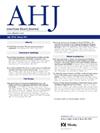替西帕肽vs西马鲁肽治疗冠状动脉疾病和肥胖:来自TriNetX研究网络的真实世界心血管结局分析
IF 3.5
2区 医学
Q1 CARDIAC & CARDIOVASCULAR SYSTEMS
引用次数: 0
摘要
背景:新的以肠促胰岛素为基础的治疗方法已经证明了除血糖控制外的心血管益处。本研究比较了替西帕肽与西马鲁肽治疗冠心病(CAD)和肥胖症患者的心血管结局。方法使用TriNetX研究网络,我们确定患有CAD和肥胖(BMI≥30 kg/m²)的成年人,他们服用替西帕肽(n=43,023)或西马鲁肽(n=110,544)。在倾向评分匹配后,每个队列中仍有43019名患者。主要结局为全因死亡率。次要结局包括心力衰竭、心律失常、肾脏并发症和肺部结局。结果与西马鲁肽相比,司他帕肽治疗的全因死亡率较低(1.1% vs 1.7%, HR 0.65, 95% CI 0.58-0.73; p<0.001)。替西帕肽的使用还能降低心力衰竭(4.1% vs 5.4%, HR 0.76, 95% CI 0.70-0.81; p<0.001)、房颤(2.3% vs 2.9%, HR 0.79, 95% CI 0.72-0.87; p<0.001)、心源性休克(0.3% vs 0.4%, HR 0.74, 95% CI 0.58-0.94; p=0.012)和急性肾损伤(3.5% vs 4.0%, HR 0.86, 95% CI 0.80-0.93; p<0.001)的发生率。在肺栓塞、肺水肿和脑血管疾病中也观察到类似的益处。结论:在冠心病和肥胖患者中,与西马鲁肽相比,替西帕肽的死亡率更低,心血管和肾脏并发症的风险也更低,这表明这两种以肠促胰岛素为基础的治疗在心肾保护方面存在差异。本文章由计算机程序翻译,如有差异,请以英文原文为准。
Tirzepatide vs Semaglutide in Coronary Artery Disease and Obesity: Real-World Cardiovascular Outcomes Analysis from the TriNetX Research Network
Background
Novel incretin-based therapies have demonstrated cardiovascular benefits beyond glycemic control. This study compared cardiovascular outcomes between patients with coronary artery disease (CAD) and obesity treated with tirzepatide versus semaglutide.
Methods
Using the TriNetX Research Network, we identified adults with CAD and obesity (BMI ≥30 kg/m²) prescribed either tirzepatide (n=43,023) or semaglutide (n=110,544). After propensity score matching, 43,019 patients remained in each cohort. The primary outcome was all-cause mortality. Secondary outcomes included heart failure, arrhythmias, renal complications, and pulmonary outcomes.
Results
Tirzepatide treatment was associated with lower all-cause mortality compared to semaglutide (1.1% vs 1.7%, HR 0.65, 95% CI 0.58-0.73; p<0.001). Tirzepatide use also demonstrated reduced incidence of heart failure (4.1% vs 5.4%, HR 0.76, 95% CI 0.70-0.81; p<0.001), atrial fibrillation (2.3% vs 2.9%, HR 0.79, 95% CI 0.72-0.87; p<0.001), cardiogenic shock (0.3% vs 0.4%, HR 0.74, 95% CI 0.58-0.94; p=0.012), and acute kidney injury (3.5% vs 4.0%, HR 0.86, 95% CI 0.80-0.93; p<0.001). Similar benefits were observed for pulmonary embolism, pulmonary edema, and cerebrovascular disease.
Conclusion
In patients with CAD and obesity, tirzepatide was associated with lower mortality and reduced risk of cardiovascular and renal complications compared to semaglutide, suggesting differences in cardiorenal protection between these incretin-based therapies.
求助全文
通过发布文献求助,成功后即可免费获取论文全文。
去求助
来源期刊

American heart journal
医学-心血管系统
CiteScore
8.20
自引率
2.10%
发文量
214
审稿时长
38 days
期刊介绍:
The American Heart Journal will consider for publication suitable articles on topics pertaining to the broad discipline of cardiovascular disease. Our goal is to provide the reader primary investigation, scholarly review, and opinion concerning the practice of cardiovascular medicine. We especially encourage submission of 3 types of reports that are not frequently seen in cardiovascular journals: negative clinical studies, reports on study designs, and studies involving the organization of medical care. The Journal does not accept individual case reports or original articles involving bench laboratory or animal research.
 求助内容:
求助内容: 应助结果提醒方式:
应助结果提醒方式:


